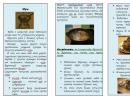The building of the 1st city hospital. Story. Brief history of the hospital
The end of the 18th century was marked by a significant event for the capital - Prince Golitsyn bequeathed funds for the construction of a hospital, which the city really needed. The funds for its construction were left by the prince after his death, and the will indicated that they should be spent on the construction of an institution “pleasing to God and useful to the people.” The proceeds from the sale of a unique collection of paintings, to the collection of which Dmitry Mikhailovich devoted most of his life, were invested in construction. In addition, 850 thousand rubles and profits from two estates that once belonged to the prince were added here. It should be noted that in those days this money was very large, and it was more than enough to organize a medical institution.
Already on July 20, 1796, the cousin of the deceased, fulfilling his last will, began construction of a future hospital on Bolshaya Kaluzhskaya Street. For this purpose, a plot of land was purchased in advance and a building project was drawn up. Construction began according to the project of the famous Russian architect Bazhenov. And after his death, a new project manager was appointed. The architect Kazakov did not experiment and the building plan became traditional for that time. The central part of the buildings for patients, wings for doctors and medical staff, the front courtyard - everything led to the fact that the hospital would truly become the main decoration of the capital city.
On the summer day of July 22, 1802, the hospital hospitably opened its doors. The chief physician, by general recognition, was the outstanding surgeon, professor at Moscow University E. O. Mukhin. He successfully headed the new medical institution. Since the hospital was initially intended to treat all segments of the population, regardless of their religion and nationality, a year after its opening, the Chief Physician canceled the payment for treatment. The exception was the serfs - for them the service remained paid. Thus, the last will of Prince Golitsyn regarding the charitable, non-profit nature of the founding of the institution was brought to life.
In 1832, the country's first paramedic school began operating within the hospital's walls. For a long time it produced the best nursing staff. In 1868, the Maternity Hospital began its activities as part of the Golitsyn Hospital. And in 1876, an outpatient clinic began operating, where patients came for consultation. We can say that the beginning was made of the opening of clinics that still exist today.
Already in the next century, 1919, the hospital merged with the 1st Gradskaya. It was founded by Prince Golitsyn’s brother, Dmitry Vladimirovich, in 1832 using city funds. This was the first time that a medical institution was built and maintained by a city.
In 1866, with the assistance of the city authorities in the person of Prince Shcherbakov, who at that time held the post of mayor, the 2nd city hospital began to function. In honor of the 50th anniversary of the famous surgeon Pirogov, 48 of the 240 beds were renamed “Pirogovsky”, and the building itself where they were located began to be called Pirogovsky. At the beginning of the 20th century, in 1914, clinics for venereal and skin diseases, called Lyubimovskys, were included in the hospital buildings.
After the Second World War, in 1959, all four institutions - 1st and 2nd City Hospitals, Golitsynskaya and Lyubimovskaya - were united into one medical institution, named after the famous surgeon City Clinical Hospital No. 1 named after N.I. Pirogov. The institution performed not only a medical, but also an educational function. Within its walls the formation of famous professors, doctors, scientists, such as F.A. Rein, M. A. Marcus, N. K. Bogolepov, N. F. Lezhnev, N. A. Lopatkin, O. V. Rutkovsky, A. D. Ado, E. I. Gusev and many others.
The mission of the Russian Orthodox Church is of great importance in the work of the hospital. From the moment the foundation was laid, the work of the temples located on the territory of the institution did not stop. Since 1794, the Church of St. Demetrius, the oldest church building in the hospital complex, has been welcoming believers. Already in 1990, the temple returned to the Russian Orthodox Church.
The First City Hospital is a symbol of faith and help to those in need. The initial charitable mission of the medical institution, voiced by Prince Golitsyn, is still relevant today. This is a place where everyone will find help in matters of health and faith. Located in the very center of the capital, the complex is probably known not only to local residents, but also to city guests. This holy place cannot be ignored.
For City Day, many buildings in Moscow are being spruced up. This is especially true for historical buildings that continue to function and are not just an architectural monument, but an important object of city, regional or federal significance. The First City Hospital on Leninsky Prospekt is one of these architectural complexes. Moreover, it is the first not only for Moscow, but also for many Russian cities. Difficult diseases are treated only here, and doctors of some diseases are rare specialists in their field. But in our case, the text will not be full of medical terms, but will tell about the past and present of the building complex itself.

photo yoko_squaw
According to federal law (Article 61???), security prohibited me from taking photographs on the hospital grounds, so I will illustrate the material with other people’s photographs indicating the source.
The reconstruction of buildings on the hospital grounds is being completed, so this is a good opportunity to talk about the history of the architectural complex and what it looks like now.
The building of the Golitsin Hospital as part of the complex (pictured below) is considered one of the best works of the famous Russian architect Mikhail Kazakov. The main building of the building is decorated with a portico and a dome raised to the ground floor.
The ensemble of the 1st City Hospital was created in 1826 - 1832. according to the project of O. I. Bove.

So, the official name of the hospital today is City Clinical Hospital No. 1 named after N.I. Pirogov, but people still call it the First City Hospital. It acquired this name in the 19th century.
The hospital dates its history from July 22, 1802. On this day, the Golitsyn hospital, built by Dmitry Mikhailovich Golitsyn, admitted its first patient. In fact, this institution was not yet related to the First City Hospital, but later it became part of the complex of buildings and buildings of the First City Hospital.
There is an interesting historical fact about the First City: the former Golitsynskaya, unlike many other buildings, survived the invasion of Napoleon. In Moscow, occupied by the French, it served as a hospital for wounded soldiers of the enemy Napoleonic army. Napoleon's life physician Dominique Larrey then said: “The Golitsyn hospital is the best hospital in Europe.”

In 1828, construction of the First City Hospital began next to the Golitsyn hospital. On October 27, 1833, the First City Hospital received its first patients. The first hospital, built with public money, like Golitsynskaya, was intended for the poor and was the largest in terms of the number of beds. Later, new buildings for the maternity hospital and gynecology, a therapeutic department with an outpatient clinic, and a department for skin diseases were built.
On March 22, 1866, a hospital for typhus patients was built nearby. The hospital building was rebuilt from two premises of a former cloth factory, connected by the Church of the Banner of the Mother of God. There was also a debtor's prison adjacent to it. Later the hospital was named the Second City Hospital, and since 1902 it bore the name of the Moscow mayor, Prince Shcherbatov.
Main hospital building
In 1924, by decree of V.I. Lenin, a building was built on the territory of the second city building. Currently, it houses a urological center, and in the building of a debt prison there is a Consultative and Diagnostic Center.
In 1919, the Golitsyn hospital lost its independence and became part of the First City Hospital. In 1959, the Shcherbatovskaya hospital joined it. After the merger of three hospitals, the new First City Hospital named after. Nikolai Ivanovich Pirogov, which turned into one of the largest hospitals in Europe.

Pathological and anatomical department - morgue
photo
Pavlovsk (fourth city) hospital. Photo: www.mosgorzdrav.ru
Exactly 250 years ago, on September 25, 1763, by decree of Catherine II, the first public hospital was opened in Moscow..
Pavlovsk hospital
The history of the appearance of the first “people's” hospital is as follows: in 1762, Catherine II arrived in Moscow for her coronation. She was accompanied by her son Pavel, who suddenly fell seriously ill. The best doctors were called in to treat the heir. Everything worked out well, and in memory of Pavel Petrovich’s deliverance from illness, it was decided to open a hospital for the poor in Moscow.
The hospital, called "Pavlovskaya", was located in wooden buildings in the country estate of General Glebov, transferred to the treasury for debts. Initially there were 25 beds for the sick, but already in 1766 a large wooden building with a church and 2 outbuildings for employees was built. In 1784, this building burned down, and other buildings became very dilapidated. In 1807, a large stone palace-type building with 3 floors was built.
Gradually the number of beds for patients increased and new premises were required. In 1829, 2 more stone outbuildings and 2 buildings for apartments for doctors, officials, clergy and staff were erected here. Later, even a conference room was set up, where portraits of the hospital’s founder, chief directors and managers were placed. In February 1904, by order of Nicholas II, training courses for orderlies were organized at the hospital, which marked the beginning of teaching activities. Now on the territory of the former Pavlovsk Hospital there are City Clinical Hospital No. 4, as well as the Department of Internal Medicine and General Physiotherapy of the Pension Faculty of the Pirogov Russian National Research Medical University.
Military hospital
And the oldest state medical institution in Moscow was founded in 1706. The “military hospital” was headed by Nikolai Bidloo, a Dutch doctor who had previously been the personal physician of Peter I. The main building of the hospital, which has survived to this day, was built in 1798-1802 according to the architect’s design Ivan Egotov. Now the Main Military Hospital named after Burdenko is located there.

Main military hospital named after Burdenko. Photo: ITAR-TASS
During the Patriotic War of 1812, the hospital received over 17 thousand wounded and sick, and during the First World War - about 400 thousand. Over three hundred years, almost 4 million people were treated at the hospital. Nikolai Sklifosovsky, Nikolai Pirogov and other famous Russian doctors worked here.
The hospital was not only a medical institution, but also an educational one: the first school in Russia for training doctors, as well as the first anatomical center, appeared here.
Catherine Hospital
Catherine II established another people's hospital in 1776 in the building of the former quarantine yard on 3rd Meshchanskaya Street. A decree issued on this occasion addressed to the Moscow chief of police, Nikolai Arkharov, read: “Considering that among those wandering around the world and begging in this city, there are elderly, crippled and sick people who are not able to feed themselves by their labors, and also do not belong to anyone people for whom no one cares, we, out of our natural love for humanity, decided to establish a special hospital and almshouse under the authority of the local police ... "

The historical building of the Novo-Ekaterininskaya Hospital. TASS photo chronicle, 1948
In 1833, the hospital moved to a building on the corner of Petrovka and Strastnoy Boulevard and became known as Novo-Ekaterininskaya. It was the largest medical institution in Moscow, there were 250 beds, and people of all ranks were served, the poorest of them were provided with treatment free of charge. In 1866, the Yauzsky department appeared at the Catherine Hospital, and in 1876, the Basmanny department, which later became independent hospitals. In 1871, a paramedic and midwifery school was opened on the basis of the clinic. In 1909, at the expense of the Morozovs, a maternity hospital was built here, and a little later the first tuberculosis department in Moscow.
Golitsyn hospital
The third, after Pavlovsk and Catherine, hospital for poor citizens was opened in Moscow in 1802. Prince Dmitry Mikhailovich Golitsyn bequeathed to build it with all his accumulated capital in memory of his early deceased wife Ekaterina Golitsyn. After the death of the prince, his cousins Alexander and Mikhail began construction of hospital buildings on the banks of the Moscow River. Also, the wife of Paul I, Empress Maria Feodorovna, took part in the construction of the folk hospital, attracting famous architects Vasily Bazhenov and Matvey Kazakov to the project.
Representatives of all segments of the population, except serfs, were admitted to the Golitsyn hospital for free treatment. In 1802, the hospital had 50 beds, and in 1805 - already 100. Additionally, in 1803, an almshouse for incurable patients with 30 beds was opened at the hospital.

Golitsyn Hospital, now City Clinical Hospital No. 1. Photo: ITAR-TASS, 1954
It is known that Christian Ivanovich Tsinger (grandfather of the mathematician, botanist and philosopher Vasily Yakovlevich Tsinger) served as the housekeeper (manager) of the hospital at the beginning of the 19th century for many years. During the Patriotic War of 1812, when Moscow was occupied by Napoleon's troops, he remained alone in the hospital and managed to prevent its looting, and also saved the hospital money left for his safekeeping. For conscientious service, Christian Ivanovich received the title of hereditary nobleman
Until the mid-19th century, all the chief doctors of the hospital were professors at Moscow University, and the hospital was the clinical base of the Faculty of Medicine. Now in the buildings of the former Golitsyn hospital there is city clinical hospital No. 1.
Sheremetevskaya Hospital

Sklifosovsky Research Institute (Sheremetevsk Hospital). Photo: ITAR-TASS, 1968
And the history of the famous Sklifosovsky Research Institute began in 1803 with a “hospital home” founded for charitable purposes by Count Nikolai Petrovich Sheremetev. The house consisted of a hospital with 50 beds and a shelter for 25 orphan girls. During the Patriotic War of 1812, the building of the Hospice House housed a hospital, first for the French and then for the Russian army, and later - a hospital for those wounded in the Russian-Turkish War of 1887. The wounded from the fronts of the Russian-Japanese and the First World War were also received here. In 1923, the Institute of Emergency Care was organized on the basis of the Sheremetyev Hospital.
Of course, other hospitals were opened in Moscow in the 18th and early 19th centuries, but we only talked about those that continue to operate today.






